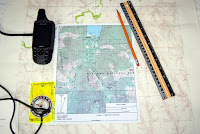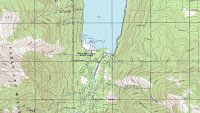|
The hunter
sat quietly through my GPS class. No questions were asked but he was
especially attentive and focused. He was “pinned to my hip” during the
night field exercise where we entered GPS waypoints and navigated through
town. The hunter had plenty of questions as we marched along using GPS
and compass.
As we wrapped
up the field portion the hunter commented, “I guess you’ve heard of me?
I know your Search and Rescue (SAR) team pretty well now.” He told me
about becoming lost during deer season in Oregon’s Three Sisters
Wilderness. After class he went into more detail. Much to his
credit, during the next class session he shared his experience of being lost
in the backcountry.
He helped his
sister field dress, hang and skin her first mule deer. No one wanted
the deer’s hide so he wrapped it up, mounted his horse and road down several
abandoned logging roads to dispose of it. His route twisted through the
wilderness. The hunter found a spot and rested a while. The lodge
pole pine was thick like a thicket. The horizon was obscured.
Prior to this
trip he had built a first aid and survival kit filled with gear. But
today his pack with the GPS, fire starter and shelter remained in camp.
After all, this was a short trip. The plan was to be back well before
twilight.
Darkness
caught up when he began his return. It wasn’t long before he was turned
around and lost. Thankfully, he stayed in place through the
night. He became cold and damp from a light rain that moved through the
Cascade Mountains after midnight. Sleep was impossible.
Around 10:00
that night his sister called 911 and the county’s SAR team began to
search. He was found after first light.
Disappointed
and embarrassed, he promised to improve his backcountry skills. His
wife was emphatic about the GPS class offered at the Community College.
This scenario
is repeated all too frequently across the country. People going out for
a short hike in the backcountry leave their important gear behind.
It Has to Work For You
So what
is the right stuff to carry in the outdoors? What is the minimum?
What should you consider before hitting the trail?
A climbing
group in the 1930s, The Mountaineers from Seattle authored the “Ten
Essentials” describing ten items that should always be carried in the
backcountry. “The Ten Essentials” has been modified by different groups
over the years. Consider this list the foundation of your kit.
Test you
equipment before you go afield. In my Wilderness Survival class I
emphasize the phrase “it has to work for you.” Friends enjoy providing
input and helpful suggestions. Don’t blindly assume these are sound
recommendations. Test that new stove during harsh winter
conditions. Determine if dryer lint fire starter will actually ignite
in the rain or if it will burn hot for six minutes.
Interestingly, in my Wilderness Survival class I hear,”…
this is used by the Special Forces." Well, OK, but is that really true
or better yet, is that important for your needs. Because our Special
Forces might use a “chem. light” to signal with, a bright strobe will be a
better signaling device for you when lost. It gets down to research,
experience and honest evaluation.
The bottom line is that whatever you put in your pack,
your equipment has to work for you. It needs to be able to work rain or
shine, at altitude, simply, and with little effort. Finally, wherever
you go this pack must go with you every time; no excuses.
Getting Ready
Invest
the time in your own personal training and education. Start a plan to
get ready for the next hunting season. Let me frame this for you by
suggesting the following strategies.
We
can all use a refresher in First Aid. Much has changed with CPR; the
techniques of 2000 have been improved. Give serious consideration to a
Wilderness First Aid class. This is a time consuming (16 hour), pricy
($150-$200) class that provides you with the serious tools of backcountry
emergency care. Why not make it fun and have the entire hunting party take
the class. Find classes through the American Red Cross or the National
Outdoor Leadership School (NOLS).
Understand
the basics of land navigation. Major outdoor retailers and Community
Colleges offer classes. Land navigation is not hard but it is a
perishable skill. If you are the team navigator, your skill and
techniques have to work for everyone. For more information visit my web
site at www.outdoorquest.biz.
Wilderness
Survival is a topic that has become very popular. Take a class that provides
you with the latest on new products, equipment and techniques. Classes
that take a commons sense approach to survival with modern component s is my
recommended first priority. Primitive skills could follow later and
will complement what you have learned.
Dedicate
an afternoon to serious evaluation of your hunting day pack. Lay
everything out on a table and go through it. Dump the old batteries,
refresh the first aid kit, test you gear, remove expired foods and
medications and replace what is broken.
Invest
your time at the rifle range. Treat your rifle for what it is – a
precision piece of equipment. Accuracy comes with time, effort and
patience.
Get
in shape. Backcountry travel is strenuous. Your exercise regimen
should be strenuous too. Now is the time to begin.
Step
by step you can become better prepared and ready for your fall hunt.
Develop your marksmanship and land navigation skills. Build up your
pack with the essentials that will work for you. Have confidence in
your equipment. And no matter what you do never leave the day pack and
survival gear behind.
| 







